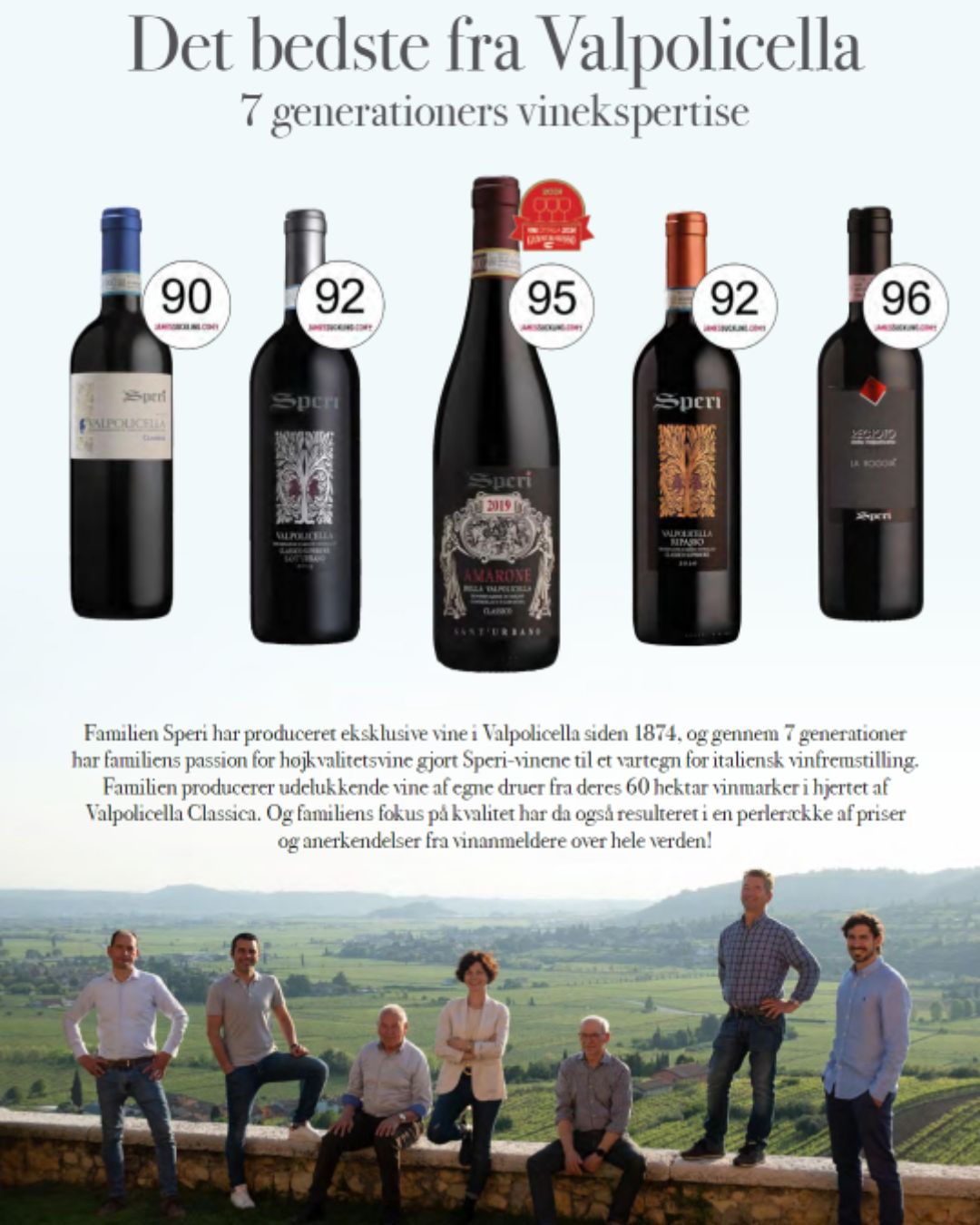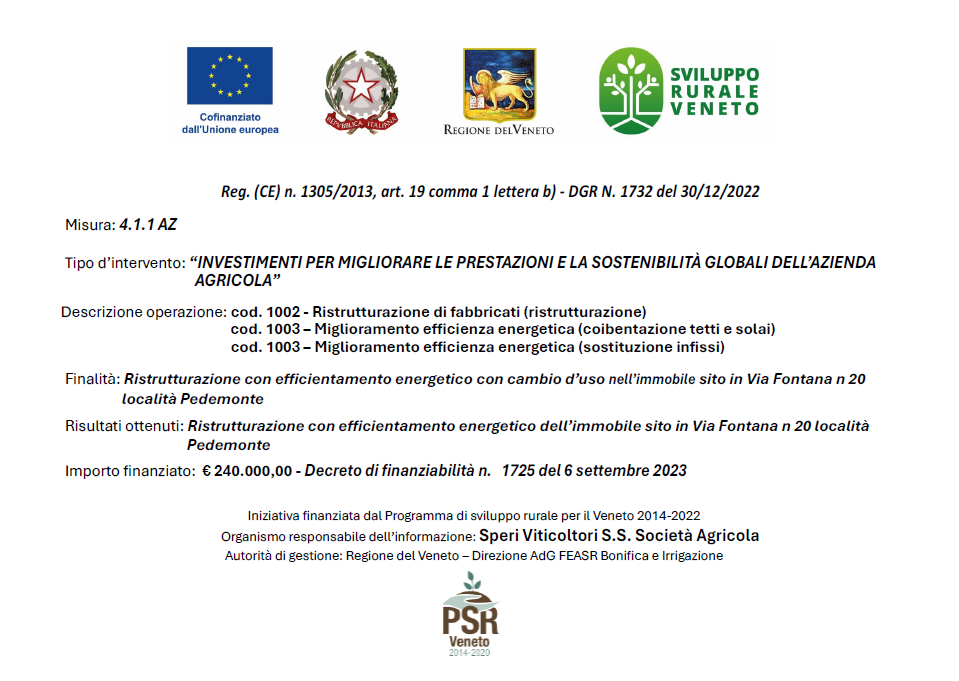SOMMELIER DK

“The birth of Speri Viticoltori dates back to 1874, as attested by the old barrel still in the cellar next to the Speri family home. The winery is in the heart of the Valpolicella Classico zone – deeply rooted in their terroir, with centuries-old experience in cultivating indigenous grape varieties, the Speris are today a point of reference locally, nationally, and internationally. The Speri family’s winemaking tradition has a long history. In early 1908, the company with Benedetto Speri received an award for quality from the Italian Association for the Development and Trade of Rome and Verona. In 1933 the Speri family bought the company’s iconic property: the Sant’Urbano estate, which consisted of about 12 hectares (today it has reached 22) and a farmhouse with a cellar and drying loft on the hills of Fumane between 280 and 350 meters above sea level. This was a privileged position for growing vines and olives, but particularly difficult to cultivate and manage, especially for that time. After the World War II the winery accelerated its development thanks to a general economic recovery and the new forces in the company, with the four Speri brothers (fifth generation) – Giuseppe, Eliseo, Benedetto and Carlo, by their father Sante.
THE OFF-SET
In the 1950s, the terracing of the Sant’Urbano vineyard began, to facilitate cultivation and increase the quality level of production. In those years, in 1958 to be precise, the first Speri Amarone was released, making Speri one of the first producers of the iconic wine of Valpolicella. Also between the 1940s and 1950s, with Speri Sante, the first bottles of Recioto Speri were on the most prestigious tables in Verona, and in the 1960s Speri wines were already appreciated not only in local restaurants and those in northern Italy but also in those beyond the Alps, in Switzerland for example. As early as the 1970s, in order to enhance the uniqueness of each plot of land, the Speri family began vinifying the grapes from the individual plots separately, producing the first single-vineyard wines: “Amarone Classico Sant’Urbano”, “Valpolicella Classico Superiore Sant’Urbano” and “Recioto Classico La Roggia” are the superb wines produced, each of which bears the name of the vineyard of origin. With the Speri brothers led by Carlo, a farmer-entrepreneur of great charisma and farsightedness, the first overseas exports began in 1971, to the United States, kicking off a prosperous expansion for the company which, relying on privileged partners for distribution, began to make its products known throughout Italy and beyond, so much so that today Speri wines are distributed in over 60 countries. At the same time as the development of the markets, the Speri family, always attentive to production with an eye to the agricultural aspect continued to expand its estates, purchasing prestigious vineyards exclusively in Valpolicella Classica until it reached the 60 hectares of today.
INTO MODERN TIMES AND THE FUTURE
From the mid-1970s until the early 2000s, the 6th generation gradually began to enter, first with Alberto, the oenologist who is now responsible for production and quality, then Giampaolo (administrative manager) and Giampietro (agronomist), and finally Luca (sales manager) and Chiara (marketing and hospitality manager) until the 7th generation with Giuseppe, a young oenologist who, as well as following the company’s certifications, also assists his father Alberto in production. Two more representatives of the 7th generation are arriving, namely Pier Francesco and Sara, who, although still engaged in their university studies, are already operative in the company, working alongside the family in all production tasks. The Speri Winery vinifies only Valpolicella native grapes. In addition to the three traditional grape varieties, Corvina, Rondinella and Molinara, small quantities of other lesser-known but long-standing varieties are used like Oseleta, Rossanella, Pelara, Cabrosina, etc. The Speri family, with respect for the biodiversity of the territory and with the objective of maintaining very high levels of quality, was the first to make significant modifications to the traditional Pergola Veronese training system at the beginning of the 1990s, after years of trials and observations in the field. The most important improvements concerned the inclination of the metal arm on which the shoots rest, opening up a central area to bring in more sunlight and improve the ventilation of the bunches. This new vine training system is called ‘Open Inclined Pergoletta’ (Pergoletta aperta inclinata), but many also call it ‘Pergoletta Speri’. Today it has become the most widespread system in Valpolicella and the most effective way to cultivate vines in the hills and produce Amarone. Hillside vineyards are cultivated on terraces made using dry stone walls, also called “marogne”. These, besides being a valuable means for improving hillside cultivation by slowing down runoff and making the soil safer, also have high historical and ecological value. These walls, thanks to the exposure to the sun, become solar collectors during the cold season. And a drywall terrace in the hills practically becomes a condominium for a variety of different insects, which find shelter in the wall and maintain the equilibrium of the ecosystem. All kinds can be found, from the largest to the smallest. By safeguarding a “marogna”, you safeguard biodiversity. Exclusive use of natural products against vine diseases (non-synthetic, so no pesticides or herbicides). We use bark against downy mildew, sulfur against powdery mildew and algae against botrytis and other types of rot; Leaving permanent grass on the entire vineyard area (thus guaranteeing the presence of organic substances; Speri have not used herbicides since 2004); Production of their own special herbaceous mixtures ‘Sant’Urbano mixture’ to be used as permanent grass in the vineyards. The ‘Sant’Urbano mixture’ is a blend of herbs selected to give the best results with the type of soil, climate, location, etc. Today, the Speri family produces wine under the motto “Always the same and always different”, excellently captured in each of the 5 Speri wines: Valpolicella Classico, Valpolicella Ripasso Classico Superiore,Valpolicella Classico Superiore Sant’Urbano, Amarone Classico Sant’Urbano and Recioto Classico La Roggia, authentic interpreters of Valpolicella Classico.”
Sommelier John David Poulsen
Link all’articolo completo: https://sommelier.dk/?page_id=2164

